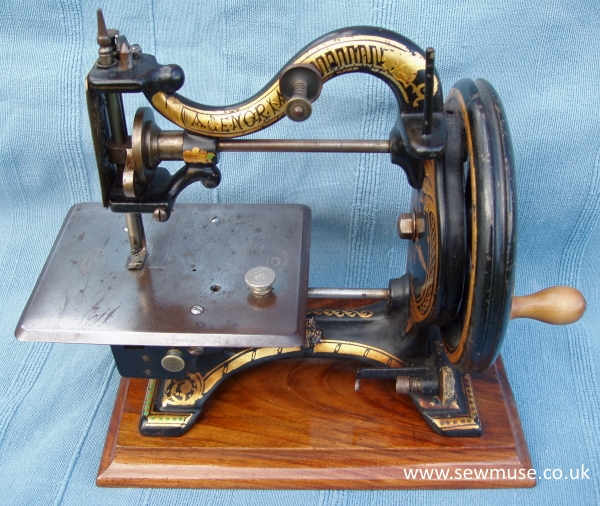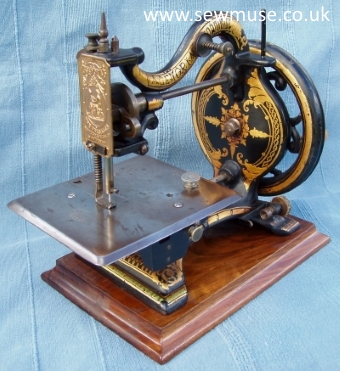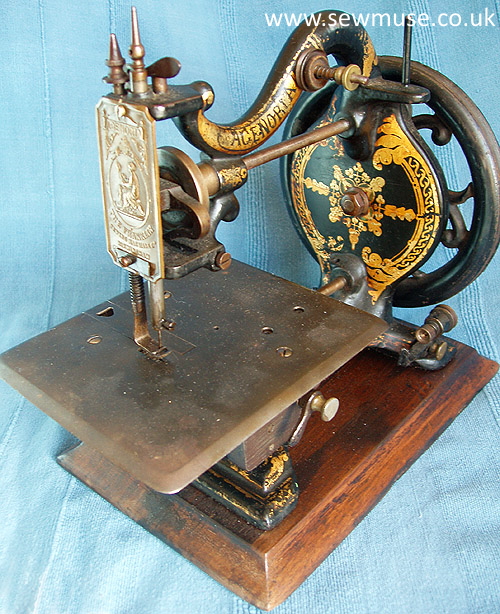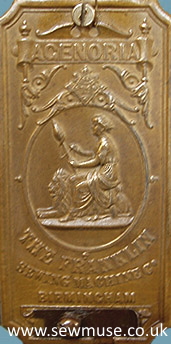Agenoria Sewing Machine This web page Copyright © 2022 David G Best All rights reserved
The Agenoria sewing machine is arguably one of the most elegant antique sewing machines in the world and deserves a place in any collection of antique sewing machines.
It's basic shape remained unchanged despite being made by various manufacturers and all bear a representation of the deity Agenoria - Goddess of Industry & Silence seated next to a prone Lion on the brass needlebar cover.
I have undertaken years of original research into the Agenoria sewing machine and had an article published in ISMACS News since then I have gathered fresh information and below give a brief summary of the different manufacturers and when each version of the Agenoria machine was made.
See also:
The Franklin Sewing Machine Co. and
Maxfield & Co
Cole, Maxfield & Co. Park Road Soho, Birmingham originally produced the Agenoria sewing machine. However this partnership between Isaac Cole, Arthur Maxfield & Richard Wood was short lived and was dissolved in February 1968 when Richard Wood left.
The Franklin Sewing Machine Co. was subsequently formed in March 1868, with Issac Cole and Arthur Maxfield being joined by Charles Fowkes The Franklin Sewing Machine Co registered the design of the Agenoria on 13 February 1869 with the faceplate being registered on 24th February of the same year. However by October 1872 the partners had separated & the partnership was formally dissolved through effuxion of time in November 1872.
A. Maxfield & Co was then formed by Arthur Maxfield by the Autumn of 1872 the factory being at The New Street Works, 71 & 72 Spencer Street, Birmingham. An improved version of the Agenoria was produced which had a fast & loose balance wheel (patented 20th Aug 1870) and an especially ornate version was supplied to HRH the Princess of Wales.
Maxfield and Co used an image of George & the Dragon as it's trade mark and this appears on all Maxfield's machines and although the name Agenoria was used in Maxfield & Co's advertising later machines have Maxfield on the arm rather than Agenoria.
On 26th November 1877 the firm's equipment was sold off and Arthur Maxfield was adjudicated bankrupt.
Charles Fowkes & Co. produced Agenoria machines at the Franklin Works from October 1872 using the crossed needles and bobbin Trade Mark of the old Franklin Sewing Machine Co. By December 1873 he had sold the business to Joseph Harris.
Joseph Harris having purchased the Franklin Works along with the plant & machinery produced Agenoria machines along with several other machines including the Challenge under the name the Imperial Sewing Machine Co. which he'd previously formed with John Judson (April 1873).
The machines were retailed through Harris's premises at Oriel House, 41 Bull Lane, Birmingham. By April 1878 the business had been sold to The Royal Sewing Machine Co. Ltd and Joseph Harris later became a director of that company.
The Royal Sewing Machine Co. advertised that it had purchased the business of Joseph Harris in April 1878. Initially it continued to produce both it's own range of machines as well as those of the Imperial Sewing Machine Co. which included the Agenoria.
It would appear that the Royal Sewing Machine Co. ceased production of the Agenoria by 1882. This was around the same time the company became the Royal Machine Manufacturing Co and may have been part of the rationalisation of the business as they already produced the Shakespear machine which was the same class and of their own desgin.
Thomas Norton produced a limited number of Agenoria machines at Summerhill, Birmingham. These featured a fast & loose balance wheel as well as level wind for the bobbin winder. The only advertising I have for this manufacturer indicates he was operating in the late 1870's early 1880's.
As part of our research we maintain a database of Agenoria machines to add your machine Contact Us please include a photograph of your machine its serial number along with any other information given on the cloth plate.

Agenoria Serial No. 4201.
Made by The Franklin Sewing Machine Company, Franklin Works, Park Road, Birmingham probably c1869 and has the name Agenoria on the arm.
The brass needlebar cover has a representation of the deity Agenoria - Goddess of Industry & Silence seated next to a prone Lion, there is also a Registered Design lozenge for 24th February 1869 which appears centrally just beneath the machines name.
Engraved on the cloth plate is the company trade mark which represents a bobbin with crossed needles with "The Franklin Co." arched over it.
The cloth plate also has a stamp for S. Smith & Co 4 Charles St Soho London. The firm was established in 1867 and retailed sewing machines of various makes. The Charles Street premises were opened in late 1868 and the firm also had branches at Soho Bazzar, Edgeware Road and Queen Victoria Street.


Agenoria Serial No. 6909.
Another example of this beautiful machine probably produced c1870.
It is almost identical to the earlier machine but the balance wheel has a blanked boss which was in preparation for the provision of the fast & loose balance wheel.


Agenoria Serial No. 13710.
This example was produced by A Maxfield & Co which was established in late 1872 following the disolusion of Franklin Sewing machine Company.
This machine dates to 1873 as by 1874 the company was advertising that upwards of 14,000 Agenoria machines had been produced. It should be noted however that as Maxfield started his serial numbers at around 10,000 this was actually only the 3,710th machine produced by Maxfield & Co.
On the clothplate this machine bears both Maxfield & Co's George & Dragon trade mark as well the eye trade mark of Cole & Co Edinburgh
The machine looks the same as those produced by the Frankin Sewing Machine Co but has the fast & loose balance wheel which Maxfield had previously patented (20th Aug 1870).



Agenoria Serial No. 4201.
Made by The Franklin Sewing Machine Company, Franklin Works, Park Road, Birmingham probably c1869 and has the name Agenoria on the arm.
The brass needlebar cover has a representation of the deity Agenoria - Goddess of Industry & Silence seated next to a prone Lion, there is also a Registered Design lozenge for 24th February 1869 which appears centrally just beneath the machines name.
Engraved on the cloth plate is the company trade mark which represents a bobbin with crossed needles with "The Franklin Co." arched over it.
The cloth plate also has a stamp for S. Smith & Co 4 Charles St Soho London. The firm was established in 1867 and retailed sewing machines of various makes. The Charles Street premises were opened in late 1868 and the firm also had branches at Soho Bazzar, Edgeware Road and Queen Victoria Street.


Agenoria Serial No. 6909.
Another example of this beautiful machine probably produced c1870.
It is almost identical to the earlier machine but the balance wheel has a blanked boss which was in preparation for the provision of the fast & loose balance wheel.


Agenoria Serial No. 13710.
This example was produced by A Maxfield & Co which was established in late 1872 following the disolusion of Franklin Sewing machine Company.
This machine dates to 1873 as by 1874 the company was advertising that upwards of 14,000 Agenoria machines had been produced. It should be noted however that as Maxfield started his serial numbers at around 10,000 this was actually only the 3,710th machine produced by Maxfield & Co.
On the clothplate this machine bears both Maxfield & Co's George & Dragon trade mark as well the eye trade mark of Cole & Co Edinburgh
The machine looks the same as those produced by the Frankin Sewing Machine Co but has the fast & loose balance wheel which Maxfield had previously patented (20th Aug 1870).

